- Value of Culinary Education
- Financing Your Education
- Austin Student Life
- Boulder Student Life
- Culinary & Pastry Careers
- Hospitality Careers
- Health & Wellness Careers
- Food Entrepreneurship
- Success Stories
- World of Food & Drink
- Recipes & Techniques
- Culinary Arts
- Baking & Pastry Arts
- Blog Search
- Financial Aid
- Career Services
- Culinary Arts Programs
- Baking & Pastry Programs
- Food Entrepreneurship Programs
- Plant-Based Programs
- Holistic Nutrition & Wellness Programs
- Hospitality & Restaurant Operations Management
- Enthusiast Cooking Classes (not related to degree or diploma programs)
- Online Programs
- Austin Campus
- Boulder Campus
- Tuition & Fees
- Financial Aid Process
- Scholarships & Grants
- Application Process
- Military & Veterans
- High School Students
- International Students
- Student Stories
- Open Houses & Events
- Our Chef Instructors
- Chef-in-Residence Kristen Kish
- Farm to Table ® Experience
- Accreditations
- Vision, Mission & Core Values
- Alumni Profiles
- History & Timeline
- Student Login
- (855) 955-7555
- Search for:
- Request Information

The Art of Food Presentation
Why is food presentation important? Here’s how plating techniques can create a multi-sensory experience for diners.

Take the Culinary Career Survey
We’ve compiled a checklist of all of the essential questions into one handy tool: career options, culinary interest surveys, educational opportunities, and more.
By clicking the "Get the Survey Now" button, I am providing my signature in accordance with the E-Sign Act, and express written consent and agreement to be contacted by, and to receive calls and texts using automated technology and/or prerecorded calls, and emails from, Auguste Escoffier School of Culinary Arts at the number and email address I provided above, regarding furthering my education and enrolling. I acknowledge that I am not required to agree to receive such calls and texts using automated technology and/or prerecorded calls as a condition of enrolling at Escoffier. I further acknowledge that I can opt-out of receiving such calls and texts by calling 888-773-8595, by submitting a request via Escoffier’s website , or by emailing [email protected] .
Listen to This Article:
You’re sitting down at that new restaurant everyone’s been raving about. The server at last brings out the plate… and you finally get it.
A savory spinach-and-feta crêpe that makes your mouth water just looking at it. A steaming bowl of butternut squash soup with a dollop of sour cream and sprinkle of chives. Sparkling crimson raspberries floating in a fizzy flute of champagne.
Food is not just sustenance, but a rich experience . While taste is important, food that is plated and presented well is more attractive to customers and can set the tone for the entire restaurant.
Presentation and plating can draw attention to the specific ingredients in a dish, whether for aesthetic or practical reasons. For anyone considering a career as a chef , a strong grasp of plating and presentation techniques is vital for continued professional development. These skills help culinary professionals stand out as they train, stage, and begin to work in a variety of environments.
Why Is Food Presentation Important?
Think about a perfectly plated meal you’ve enjoyed that engaged all five of your senses. Maybe it was an expertly crafted uramaki roll with razor thin avocado slices, a dusting of panko, a drizzle of unagi eel sauce, and a ginger-wasabi rose embellishing the plate’s rim. Between the greens and oranges, the spicy and salty, the shapes and textures of the garnishes… you may have decided to make the restaurant your go-to sushi joint.
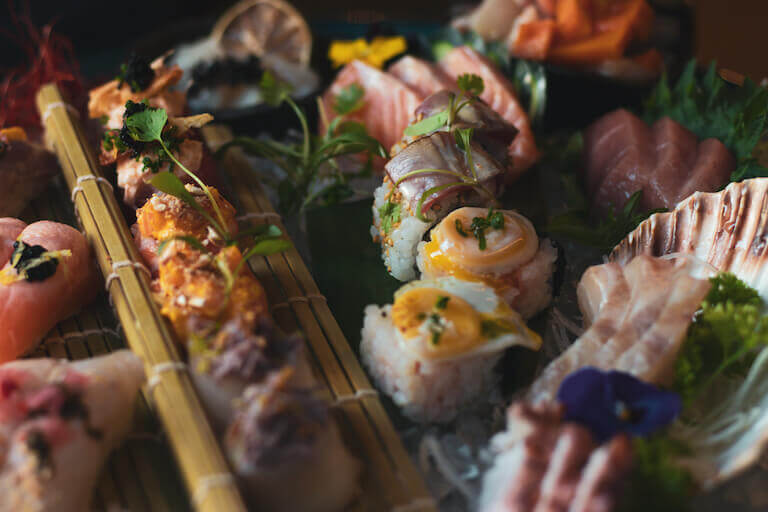
An experience like that sticks with a customer for much longer than a meal that involves mediocre presentation, and creating that kind of memory is exactly what chefs are looking for. Well-executed food presentation can create a sense of professionalism in the mind of eaters and offers an exciting element of a meal that many can’t recreate with the same skill in their own cooking efforts.
In the digital age, strong presentation can also make dishes more apt to be photographed and shared via social media . While there are definitely pros and cons around the prevalence of pre-meal photos shared on sites like Instagram, it can be an effective way to generate attention and sales for many restaurants.
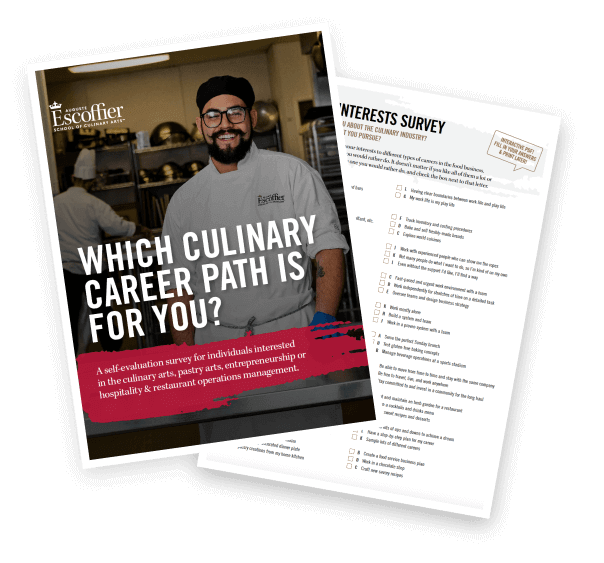
Food Plating Techniques
Important considerations to make regarding the element of appearance include the color, size, and pattern or texture of the plate.
It may be especially helpful to look at the plating and presentation process as generally following a series of steps. This starts with choosing a plate, then deciding how the main dish and core sides are arranged or layered. From there, it’s common to move onto sauces to create visual contrast and shapes that aren’t easily rendered with more solid food. Finally, the garnish provides a finishing touch.
Bright colors work well against a dark background, while more neutral or subdued colors can use a white background to create some visual excitement. Besides the colors of the foods, different techniques for adding color might include the use of sauces, spices, and garnishes like fruits or flowers.
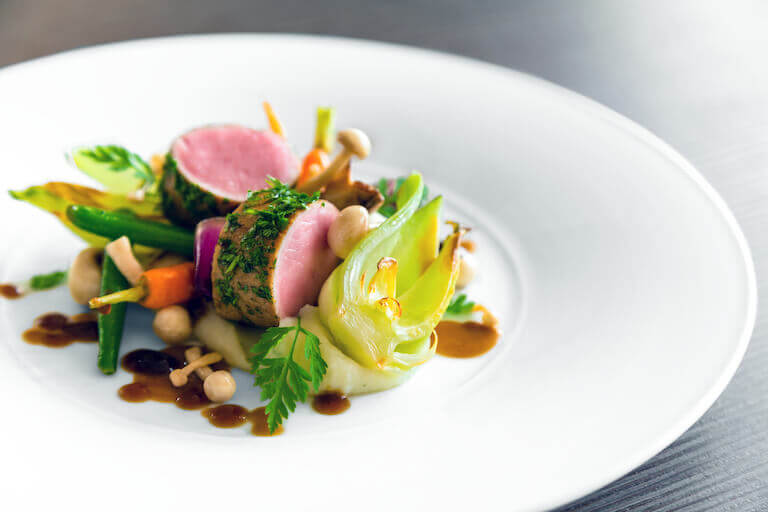
Thinking about the ratio of food to plate is another technique that involves some artistry. Serving a smaller portion of food on a large plate for more white space, or serving dishes in miniature receptacles can be interesting ways to present food masterfully.
Of course, you have to balance practical and artistic considerations – food should never be difficult to eat nor excessively messy because of the vessel it’s served on or in.
Beyond plates and bowls, the arrangement of foods is key. There should be a star item, one that takes top billing and is also likely the largest portion on the plate. This approach avoids visual competition and instead allows the sides to support the main dish.
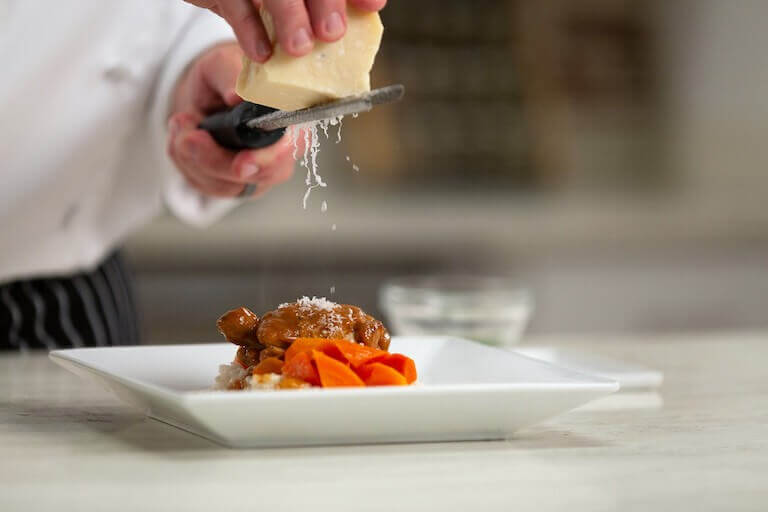
It’s also important to think in three dimensions, as the height of food on a plate can also entice diners. Stacking items for a layered look can be visually appealing and make the meal appear more substantial than it would scattered across the plate.
Skills Involved in the Plating Process
How can you make sure you plate effectively and provide the best possible presentation to customers? There are many different considerations, from how to incorporate sauces and garnishes to the knife skills needed for flourishes like a vegetable rosette, and the plate you use is undeniably foundational.
Many people get their start in culinary school . Earning a culinary arts degree or diploma from Escoffier can help students explore techniques and hone skills in plating. Talk to an Admissions Representative to explore your options.
Here are some other articles you might like:
- How Restaurants Get Michelin Stars: A Brief History of the Michelin Guide
- Gen-Z Food Habits & Influences
- The Latest in Food Tech
This article was originally published on February 20, 2019, and has since been updated.
*Information may not reflect every student’s experience. Results and outcomes may be based on several factors, such as geographical region or previous experience.
Latest Articles
Plant-based vs. vegan: why chefs need to know the difference.
Uncover the differences between plant-based and vegan diets and learn why chefs need to know these distinctions for better customer satisfaction.
What Is a Sous Chef?
Discover what it takes to become a sous chef, from education to essential skills, and discover the rewarding path to becoming an executive chef.
World’s Most Expensive Foods: 10 of the Priciest Ingredients on the Planet
If price were no object, what would you put on your dream menu? Maybe something from this list of 10 of the most expensive foods in the world?

Subscribe to the King of Chefs Blog
Get the King of Chefs email newsletter delivered to your inbox weekly. You'll get everything you need to know about culinary & pastry careers, food entrepreneurship, financing your culinary education, and more.
We’ve compiled a checklist of all of the essential questions into one handy workbook: Career options, academic plans, financing your education, and more.
By clicking the "Get the Workbook Now" button, I am providing my signature in accordance with the E-Sign Act, and express written consent and agreement to be contacted by, and to receive calls and texts using automated technology and/or prerecorded calls, and emails from, Auguste Escoffier School of Culinary Arts at the number and email address I provided above, regarding furthering my education and enrolling. I acknowledge that I am not required to agree to receive such calls and texts using automated technology and/or prerecorded calls as a condition of enrolling at Escoffier. I further acknowledge that I can opt-out of receiving such calls and texts by calling 888-773-8595, by submitting a request via Escoffier’s website , or by emailing [email protected] .

Inspirationfeed
Inspiring and educating bright minds.
The Importance of Food Presentation, Explained by a Chef

Last Updated on August 9, 2024
Table of Contents
More than just taste
Most of us go through life enjoying our favorite foods as unfancy meals that can be found just about anywhere.
But for every foodie, there comes a time when we get to sample something prepared by a real pro. When you eat something created by a Chef with a real vision, every detail is just right.
The flavors will be impressive, of course, and the ingredients will be fresh, but the presentation is where things really get interesting.
Compelling food presentation is one of the main reasons for the rise of foodie social media culture.
For many restaurants and Chefs, making use of creative presentation doesn’t just provide guests with a great experience, it also serves as a smart marketing move, as the guests will be tempted to share photos of the meal with their friends and followers.
We’re going to explore food presentation, food carving, and why even amateur cooks should care about the visual element of every dish.
To get some answers, we talked to an expert in food presentation and food carving: Effie Noifelt. Noifelt has spent years as a Private Chef and master carver, creating elaborate displays from fruit and vegetables for festivals and special events.
Even if you’re not looking to do any carving or arranging yourself, you’ll gain a greater appreciation for just how much care and effort goes into making food not just taste great, but look great too.
How presentation can upgrade a meal

Presentation is important, plain and simple, but it still tends to fall by the wayside at many restaurants and even in some culinary schools.
We definitely need to be clear about this point: the food itself always takes priority, and we would never want to imply that presentation can make up for food that may be lacking in flavor and fresh ingredients. It’s not true.
However, ignoring the power of presentation represents a missed opportunity and a large one at that.
Eating is a multi-sensory experience, and seeing a dish that has been presented just so can make a culinary experience that much more memorable.
Still don’t believe us? Here’s a short test you can try. Grab yourself a simple snack– anything that’s not very complex.
A few crackers or toast will do fine. Now, before taking the first bite, hop on your phone or computer and pull up a photo of a gourmet meal or an elaborate dish created on a cooking competition show.
Your snack is going to taste better.
No, you won’t get all the complex flavors of your visual aid, but we trust you get the point.
Eating isn’t just the work of your mouth and taste buds, it also involves your sense of smell, touch, and sight, meaning your brain is in on the action as well.
Great presentation takes a meal to another level, and Noifelt agrees, noting that food offers so many different opportunities for mental and sensory stimulation.
Good presentation upgrades the dish. The plate itself becomes an artistic canvas to be filled with colors and textures. The colors have to be balanced with certain kinds of textures and direct the client to travel with the utensils to an experience that will result in stimulation of the other senses.
Presentation is important, but what’s the next step? Do only professionals get to delve into complex food presentations or can amateurs get involved, too? Let’s find out.
Learning presentation

If you attend culinary school, you will learn a bit about food carving and a lot about food presentation.
Where it gets tricky is in the artistic side of the presentation. Food preparation, for example, is fairly black and white. There are safe food handling guidelines that must be followed, cooking temperatures are more or less pre-determined, and cooking times aren’t that flexible.
Presentation is based solely on creativity, so while certain techniques and trends can be taught, original ideas need to come from the individual.
Noifelt told us that food carving, in particular, is a balance between technical skill and creative thought.
It takes talent and a lot of practice time in order to learn intricate food presentation. You need to know how to use your tools for one thing. Food carving requires many different knives, for example. But you also need to come up with your own ideas. In the end, this is just as important.
So can amateurs get involved with food carving and creative presentation? Absolutely. The only catch is that you’ll need to be willing to gather the tools yourself and commit plenty of time in order to find your own style.
In the beginning, it’s acceptable to just mimic presentation styles you’ve seen on TV or online. In many cases, this will be enough to impress dinner guests, but getting to that next level is going to require introspection and plenty of experimentation.
Get creative! You can even draw quick sketches of your ideas before you step into the kitchen.
If you’re feeling really ambitious, order a few stylish plates and platters. You’ll be surprised how changing your canvas inspires fresh ideas.
If you’re looking for resources on how to get started with home cooking and baking , click these links for some helpful videos that explain the basics.
Theming your dish/carving

There are plenty of Chefs, amateurs and pros alike, who find one visual theme and stick with it through each and every meal.
This is fairly common in the world of fine dining, where for many years ring-based presentation has dominated.
When it comes to food carvings, flowers are one of the most common shapes.
But sticking to a unique theme for each event can really make a meal feel special.
Noifelt has created carvings for many different events, and as such, she nails down a theme for each long before reaching for the carving knives. Like many great artists, she even finds ways to incorporate elements of her culture into her work.
It definitely helps to choose a theme for each display. For a wedding, the theme would be hearts and flowers made from carrots and yellow melons. For seasonal events, I like to carve butternut squashes into birds, fish, and flowers. A large fruit like a watermelon offers a great opportunity for carving an image into the skin. As a tribute to my heritage, I love to carve ancient Greek gods in my pieces.
Once again, the key here is finding your own niche. Searching for your own unique ideas isn’t just exciting, it’s an important step on the way to becoming a true culinary artist.
Every meal is a chance to tell your story, even if the ingredients are common. Sharing something special with your audience makes the culinary experience fulfilling for everyone involved, which brings us to our next point.
The fruits of your labor

Many artists are somewhat removed from their audience. A director can’t sit in on every screening of their new movie. A painter doesn’t travel around as their work cycles through various museums.
But culinary professionals, on the other hand, are typically close at hand, and while not every Chef takes the opportunity to see the reactions of their guests, Noifelt views this experience as the best part of the job.
I’ve always loved watching the faces of the people tasting my dishes. Sometimes at work, I’ll step out of the kitchen and watch my clients as they take the first bite. I’ve received a number of rewards throughout my career, but the most rewarding moment is when I see someone enjoying a dish that was made just for them.
Whether you’re a professional Chef or just a home cook, this work is all about people. The goal is to always make someone happy. It might be a group of friends or it might be just yourself, enjoying a finely-crafted meal on a Tuesday evening.
Even if your presentations aren’t especially elaborate, diners will notice the effort, appreciate it, and maybe even snap a pic to post online.
Go forth and enjoy
In a sense, food presentation may be the perfect encapsulation of the human desire for expression and reinvention.
It involves taking something common (and necessary) and making it more interesting, more appealing and creative.
Humans don’t just cook to survive, we cook to make daily life fun, to play around with our pre-existing notions of what a meal should be. We find ways to make something as simple as food express beautiful, abstract concepts.
We hope you’ve come away from this article with a greater appreciation for the ‘art’ in ‘culinary arts.’ Maybe the next time you come across a food photo on social media, you’ll be able to acknowledge it as the art piece that it is.
Posted by: Nikola Nikolovski
Nikola is a Wordpress expert who makes sure everything runs smoothly on our website. Wordpress optimization and on-site SEO are both his bread and butter.
- PRO Courses Guides New Tech Help Pro Expert Videos About wikiHow Pro Upgrade Sign In
- EDIT Edit this Article
- EXPLORE Tech Help Pro About Us Random Article Quizzes Request a New Article Community Dashboard This Or That Game Forums Popular Categories Arts and Entertainment Artwork Books Movies Computers and Electronics Computers Phone Skills Technology Hacks Health Men's Health Mental Health Women's Health Relationships Dating Love Relationship Issues Hobbies and Crafts Crafts Drawing Games Education & Communication Communication Skills Personal Development Studying Personal Care and Style Fashion Hair Care Personal Hygiene Youth Personal Care School Stuff Dating All Categories Arts and Entertainment Finance and Business Home and Garden Relationship Quizzes Cars & Other Vehicles Food and Entertaining Personal Care and Style Sports and Fitness Computers and Electronics Health Pets and Animals Travel Education & Communication Hobbies and Crafts Philosophy and Religion Work World Family Life Holidays and Traditions Relationships Youth
- Browse Articles
- Learn Something New
- Quizzes Hot
- Happiness Hub
- This Or That Game
- Train Your Brain
- Explore More
- Support wikiHow
- About wikiHow
- Log in / Sign up
- Food and Entertaining
- Food Preparation
How to Beautifully Plate and Present Food
Last Updated: July 5, 2024 Approved
Starting With Beautiful Food
- Plating a Meal
Presenting Tricky Dishes
Expert q&a.
This article was co-authored by JoAnna Minneci . JoAnna Minneci is a retired Professional Chef based in the Nashville, Tennessee area. With 18 years of experience, Chef JoAnna specialized in teaching others how to cook through private cooking lessons, team-building events, and wellness and nutrition classes. She also appeared in numerous television shows on networks such as Bravo and Food Network. Chef JoAnna received Culinary Arts training from the Art Institute of California at Los Angeles. She is also certified in sanitation, nutrition, kitchen management, and cost control. There are 18 references cited in this article, which can be found at the bottom of the page. wikiHow marks an article as reader-approved once it receives enough positive feedback. In this case, several readers have written to tell us that this article was helpful to them, earning it our reader-approved status. This article has been viewed 618,105 times.
Things You Should Know
- Cook meals with a variety of colors and complementary textures to give your meal some visual appeal even before plating.
- Default to white plates, leave 1/3 of the plate empty, and add different foods in odd numbers to achieve a balanced look.
- Layer proteins or main courses on top of filler foods like rice or noodles, and use herb or sauce garnishes to add finishing touches.

- When you're planning meals, think ahead about the colors you want to feature on the plate. You might not be able to represent all the colors of the rainbow at every meal, but challenge yourself to have as much color as possible.
- If you realize you're about to serve several like-colored foods, like grilled chicken and mashed potatoes, adding a serving or two of fruits and vegetables is a fantastic and easy way to add pops of color. The richest greens, oranges, reds, purples, blues, pinks, and yellows on your plate probably take the form of fruits and vegetables.
- If you're not sure how to add color, utilize garnishes. [3] X Research source Nearly any savory dish is well-served by a sprinkling of fresh chives, parsley, dill, or mint. Lemon and lime wedges are welcome alongside poultry and seafood dishes.

- Lightly steam them instead of boiling them. [4] X Research source Steaming vegetables makes them look appetizing and flavorful, while boiling creates the opposite effect. [5] X Research source Take broccoli, for instance: steaming broccoli turns it a fresh, bright green, and each floret retains its shape and texture. Boiling broccoli results in a mushy texture and a paler color, which isn't as pretty on the plate. The same holds true for asparagus, carrots, green beans, and many other vegetables.
- Roast or sauté them with a little oil or butter. Roasted or sauteed vegetables look quite appetizing when they're allowed to caramelize a little in oil or butter. The bright orange or green of the vegetable is offset by brown, crispy spots. It's a delicious way to cook vegetables.

- There are exceptions to the rule of searing your meat. For example, if you're serving braised beef , you'll have to think of creative ways to make the meat look appetizing even though it doesn't have a crispy crust. Serving it with a sauce is a good way to add visual interest.

- Fried foods often continue browning a bit after they've been removed from the hot oil. Carefully monitor foods as you're frying them to make sure they don't get too dark.
- Take pains to handle the fried foods gently so they look appetizing when you're ready to plate them. For example, if you need to check whether a piece of fried chicken has reached the correct internal temperature, stick the meat thermometer in a place where the resulting hole won't be visible. [8] X Research source

- The way you handle the food just after it has been cooked, and before it is plated, can really affect the texture. Pasta, for example, should be kept in water or tossed in a bit of oil just after cooking so that it doesn't start to clump. [9] X Research source Fried foods should not be covered with airtight lids because the heat from the food will end up steaming the breading and causing the food to get soggy.
- Once the food is on the plate, a spritz of oil or water can improve its visual appeal if it looks too dry.

Plating it With Care

- That said, there are exceptions. If you have a set of special plates with a pattern or a certain color scheme, it's fine to use them. Just make sure they complement the food you're serving instead of vying for attention.
- Don't forget to take the rest of the table into consideration, too. Cutlery, glasses, and linens will enhance the overall appearance of the dish upon the table.
- When looking for interesting tableware, try going to Asian grocery stores, craft or flea markets, and antique stores. You can find some very interesting tableware from all of these sources.

- As a general rule, half of the food on the plate should be comprised of vegetables, one fourth should be comprised of meat or another protein, and one fourth should be comprised of a starch.
- Start plating food in the center of the dish and work outward from there so that the food is centered in the middle of the plate.

- To quickly add some crunch to a dish, try topping it with some crushed, roasted walnuts, almonds or pepitas.
- A dollop of crème fraiche or some pieces of goat cheese can add a soft, creamy texture to savory dishes. Whipped cream or pastry cream is a good way to add a soft element to sweet dishes.

- An easy way to start layering food is to serve the protein on a bed of starch. For example, serve a kabob on a heaping of rice, or serve grilled swordfish on a pile of mashed potatoes.
- You can use sauces to layer as well. Ladle a pool of au jus, marinara, or whatever sauce you're using into the center of the dish, and arrange the other elements of the dish on top.
- Aim to make foods look bigger, not smaller. Fluff up your salads, for example, instead of smoothing them down. Create a little cross-hatched stack of cooked asparagus instead of presenting it in one flat layer. [17] X Research source

Adding Appetizing Touches

- If you serve a dish with lemon or lime wedges, consider creating slender, pretty twists instead of slicing them into thick wedges. This might entice the diner to actually use the garnish instead of scooting it to the side of his or her plate!
- Think outside the box and use garnishes you might not normally consider. Sprinkle a dash of cinnamon over a chicken dish, or a handful of pomegranate seeds over an otherwise ordinary salad. Choose garnishes that add a burst of both flavor and color.
- In many cuisines, flowers are an acceptable garnish or a large inedible leaf sitting underneath the food. In broader Western culture, it's recommended that nothing inedible be served on the plate. As well, since certain garnishes can affect the flavor, choose carefully.

- Rather than just pouring a sauce over your food, consider putting it in a squeeze bottle so you can create a pretty swirl or pattern. [19] X Research source If you don't have a squeeze bottle, put the sauce in a plastic food storage bag, cut a small piece off one of the corners, and squeeze the sauce through the bag.
- Don't overdo it. The key is to add a touch of color, flavor, and texture without overpowering the main part of the dish.

- If you're serving the pasta with a protein, arrange it attractively on the heap of pasta. For example, if the dish includes shrimp, place the shrimp on top instead of burying the pieces inside the pasta heap.
- Just before serving, you can mist the pasta with a bit of olive oil to make it glisten attractively.

- Soups and stews tend to splash and run, so it's also important to make sure that the sides of the bowl or plate you're serving them in are wiped clean before serving.
- Casseroles might also come out on the brown side. Serving them alongside a bunch of fresh salad greens is a good way to offset the neutral-looking main dish.

- Use a cookie cutter to create a neat shape. A star or leaf-shaped brownie will look more interesting than your basic square.
- Serve it with mint. Adding a few fresh sprigs is a great way to enhance many desserts, especially fruity ones.
- Sprinkle cocoa, cinnamon or powdered sugar on top. Choose the powder that contrasts in color to the dessert you made.
- Sprinkle crushed peppermints on top. It'll look like you topped your dish with pink glitter.
- Speaking of glitter, add edible glitter to the dish to take it over the top.
- When all else fails, plate it with a swirl of whipped cream. [23] X Research source You can pipe it through an icing bag fixed with a star-shaped tip to create a visually pleasing shape.

- Try keeping all presentation of the food relevant and simple. A nice formal dish is great for a celebration, but even simple meals can be improved with the addition of some herbs. Thanks Helpful 0 Not Helpful 0
- Read current cooking books and magazines for ideas. Your local library is a wonderful resource and many culinary magazines are now available for download, allowing you to read the recipes in the cooking area straight off your iPad, eReader, or other device. This also enables you to decorate a table with the electronic device as a reference! Thanks Helpful 0 Not Helpful 0
- There are now plates that keep food hot (patented). An excellent final touch for certain delicious hot recipes (Especially if they are expensive and time-consuming to prepare). Thanks Helpful 0 Not Helpful 0

Things You'll Need
- Food magazines and cookbooks
- Ideal dinnerware and tableware
- Inspiration from recipes and restaurants/cafes that you like
You Might Also Like

- ↑ JoAnna Minneci. Professional Chef. Expert Interview. 23 November 2021.
- ↑ https://www.huffingtonpost.com/2012/08/13/plating-food_n_1763865.html
- ↑ https://www.webstaurantstore.com/article/200/basic-guide-to-food-presentation.html
- ↑ https://www.thekitchn.com/how-to-steam-vegetables-cooking-lessons-from-the-kitchn-108512
- ↑ https://www.professorshouse.com/steaming-versus-boiling-vegetables/
- ↑ https://www.thekitchn.com/how-to-sear-meat-47333
- ↑ https://www.bonappetit.com/test-kitchen/how-to/article/learning-to-fry
- ↑ https://www.epicurious.com/expert-advice/how-to-use-a-meat-thermometer-article
- ↑ https://www.huffpost.com/entry/texture-of-food-cheap-spaghetti_n_5b60c302e4b0b15aba9d7d4e
- ↑ https://www.today.com/food/how-plate-your-food-pro-celebrity-chefs-reveal-their-secrets-2D80186757
- ↑ https://blog.kitchenaid.ca/10-tips-plating-food-like-a-pro/
- ↑ https://www.tablespoon.com/posts/how-to-plate-like-a-chef
- ↑ https://startcooking.com/seven-ways-to-present-food-like-a-chef
- ↑ https://timesofindia.indiatimes.com/life-style/food/food-reviews/Plate-your-food-like-a-pro/articleshow/32962204.cms
- ↑ https://www.thekitchn.com/tip-for-plating-pasta-perfectly-264049
- ↑ https://www.mirlandraskitchen.com/how-to-decorate-with-whipped-cream/
- https://www.youtube.com/watch?v=ihxsCYijU20
About This Article

When you’re plating food, try to visualize what the finished product will look like. Only fill the plate about two-thirds of the way, since the negative space will accentuate the appearance of your food. As you add elements, remember that odd numbers look more appealing than even numbers, and try to group foods with different textures near each other. Stacking and layering foods is a good way to play with height, which can create even more visual interest on the plate. For tips on choosing garnishes to finish your dish, keep reading! Did this summary help you? Yes No
- Send fan mail to authors
Reader Success Stories
Feb 14, 2017
Did this article help you?

June Bannister
Jun 16, 2017
May 5, 2016
Jun 20, 2017
Daniel Sharifi
Mar 25, 2017

Featured Articles

Trending Articles

Watch Articles

- Terms of Use
- Privacy Policy
- Do Not Sell or Share My Info
- Not Selling Info
Get all the best how-tos!
Sign up for wikiHow's weekly email newsletter

Privacy Policy | Terms and Conditions | Disclosure Statement | License Policy
COPYRIGHT © 2024 | NUMBER 8 COOKING | ALL RIGHTS RESERVED.
The Art Of Food Presentation — Plating Like A Pro
- Shannon The Helpful Chef
- November 9, 2023
I’ve learned that food presentation is just as important as taste. When it comes to creating memorable dishes that wow customers. While taste is paramount, how the food looks on the plate is almost equally as important.
The visual presentation delights customers’ eyes before they even take their first bite. An artful presentation demonstrates care, creativity, and skill. It can turn an enjoyable meal into an unforgettable dining experience.
ADVERTISEMENT CONTENT BELOW
In this blog post, I’ll share my tips and tricks for plating and presenting dishes. I’ve been a chef for 20-plus years and have learned a thing or two about plating food. Master these techniques to wow patrons and create Instagram-worthy culinary artwork with every meal.
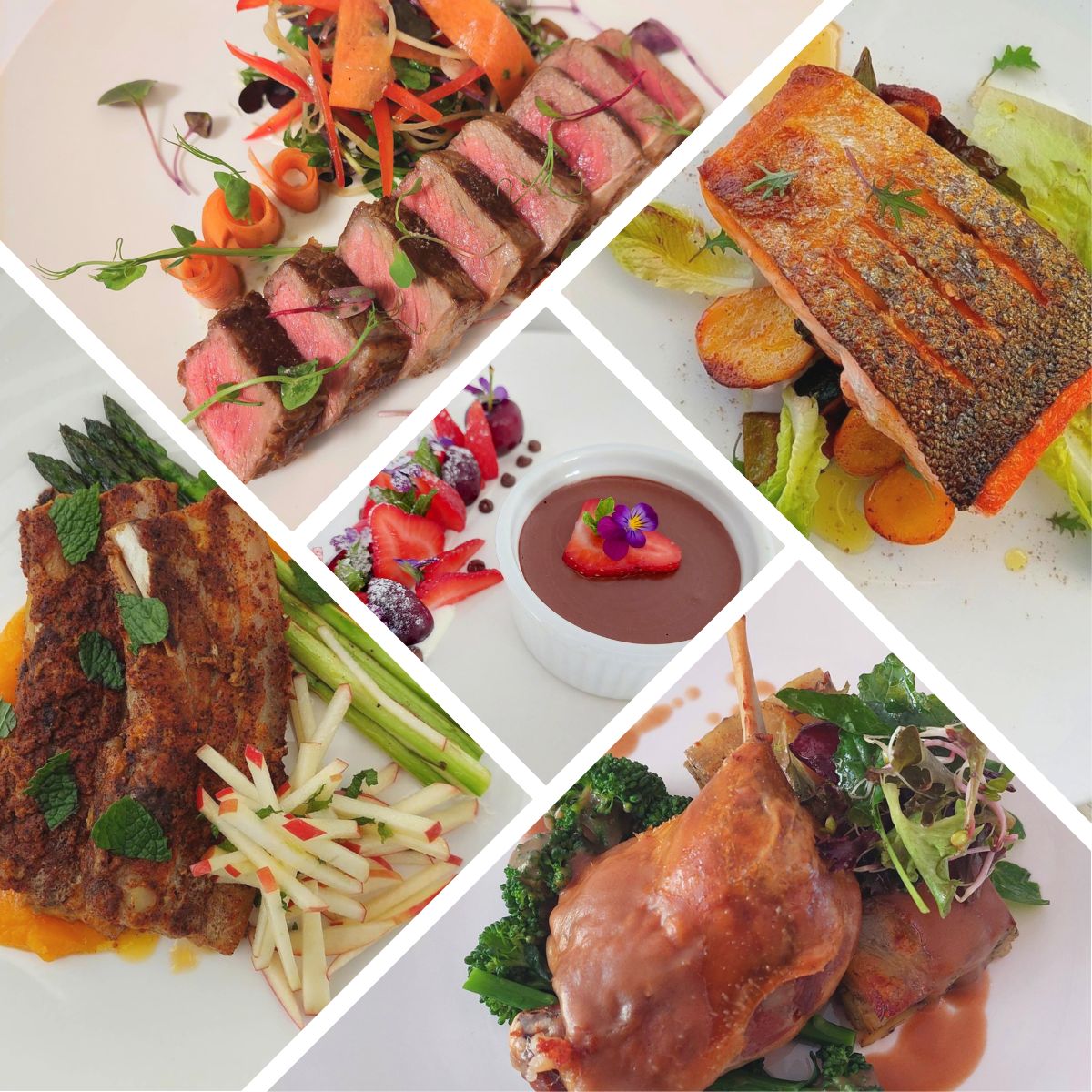
Food Presentation Plating Like A Pro
Throughout my career as a chef, I’ve come to view each plate as a blank canvas. Waiting to be turned into an edible work of art. While the flavors and textures of a dish are crucial, elegant, and enticing.
The presentation takes the meal to the next level, delighting customers and showing them you’ve put care into every component. As any successful chef knows, food presentation and plating skills are well worth developing .
Start With Quality Ingredients
Truly, exceptional ingredients make the job easier. The freshest, properly butchered proteins and peak seasonal produce. They showcase their natural beauty with minimal preparation required. While technique is important, sourcing the best seasonal ingredients gives you an advantage.
Focus on Color And Contrast
One of the keys to eye-catching presentations is playing with vibrant colors and bold contrasts. I like to feature ingredients with bright natural hues like:
- Deep Greens — Spinach, arugula, fresh herbs, lettuce leaves, zucchini, fresh peas, and green beans.
- Rich Reds — Fresh tomatoes, red bell peppers, English radishes, red beets, radicchio, red leaf lettuce, and sliced red meats cooked med-rare.
- Sunny Yellows — Squash, yellow zucchini, golden beets, corn, and yellow beans.
- Earthy Browns — Mushrooms, jacket potatoes, taro, Jerusalem artichokes, and seared or slow-cooked meats.
Contrasting colors help each component stand out. For example, I’ll place a seared med rare red meat like beef rump next to arugula or roasted potatoes to make both stand out. Varying colors excite the eyes and spark joy on the plate.
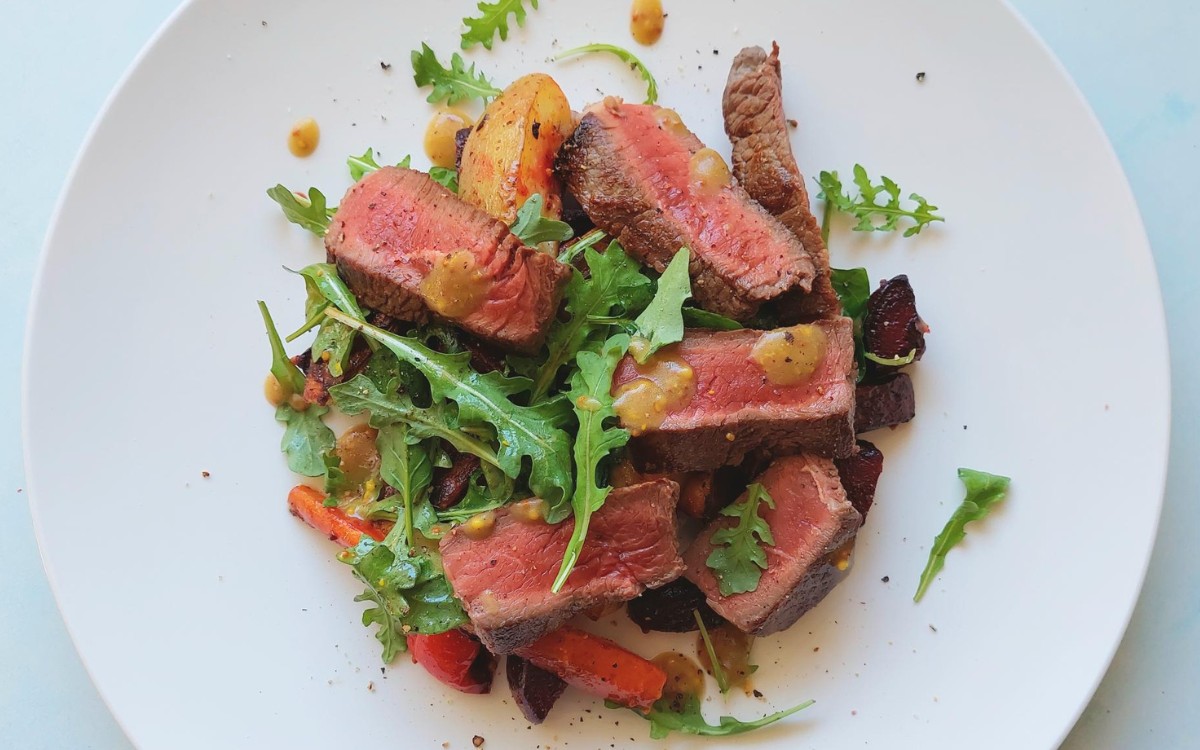
Chefs Pro Tip — Use colorful ingredients to your advantage. Don’t complicate the process, when preparing each ingredient keep it fresh and simple. You will be amazed at what plating designs you can create.
Find Inspiration In Nature
I find endless inspiration for plating designs by observing the visual beauty inherent in nature. Notice compositions like seashell spirals, patterns in flower petals, or leaves fanned on a platter. Mimicking nature’s artistry through food is a constant source of ideas.
Allow Simplicity To Shine
Sometimes simple is best if I don’t overcomplicate a presentation . When the star ingredients speak for themselves. A pristinely seared fillet of salmon needs little more than an herb oil drizzle and chive garnish to impress. Allow quality ingredients and elegant simplicity to shine when appropriate.
Draw Plating Inspiration From Anywhere
I find plating inspiration almost everywhere. Nature, artwork, and even well-designed retail displays. Study what paints a pleasing visual picture and think about how to replicate it on the plate. Inspiration is endless for those with observant, creative eyes.
Pay Attention To Shapes And Height
When conceptualizing a dish, I always consider the natural shapes and heights of each element I’m including. Mixing and balancing the shapes and vertical dimensions makes the presentation more dynamic.
For instance, balls of zucchini are cut using a melon baller. Potatoes are cut into rectangular shapes. Spears of grilled asparagus can provide vertical lines next to rounded potato rosti. Or combine the height of a vegetable salad with the low profile of a sliced seared beef. Defining individual shapes gives a satisfying composition.
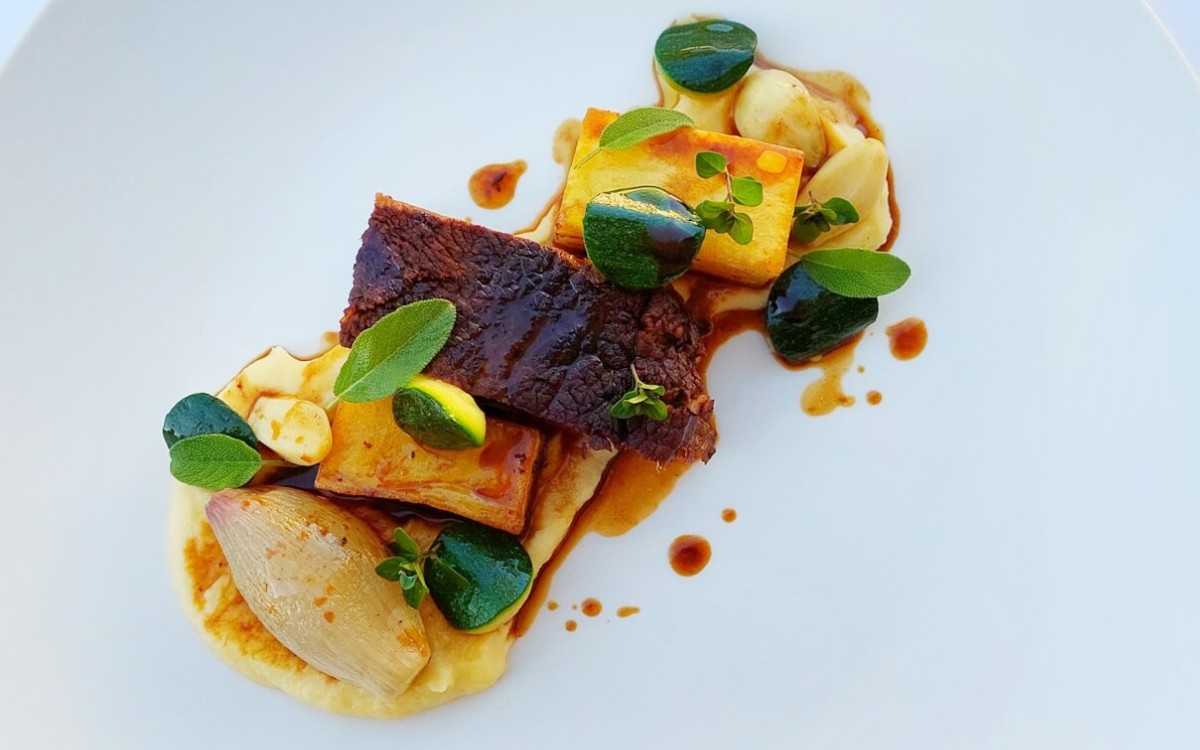
Food Presentation Go Vertical
Height adds drama and excitement to plated dishes. I build upwards with stacked ingredients like potato gratin, blanched broccolini, and a confit duck leg placed on top. Salads become more dynamic when ingredients are arranged vertically rather than tossed haphazardly across the plate. Reaching upwards with towers and heights naturally draws the diner’s eye in.
Incorporate Odd Numbers
When garnishing and portioning ingredients. Odd numbers do wonders when it comes to food presentation. Artful plating incorporates variety. Odd numbers of components like three ravioli or five haricots verts are more interesting than even pairs. The unevenness creates movement and delights the eye as it flows across the plate.
Play With Proportions
I carefully consider proportion when food presentation is the focus. The star of the dish is featured prominently with supporting sides artfully framed around. For example, an ample tenderloin takes center stage while the potatoes and vegetables are thoughtfully portioned as accents. Getting the proportions just right ensures an ideal bite each time.
Leave Negative Space
Don’t overcrowd or clutter the plate. I remind myself to leave ample negative space between the ingredients and leading up to the edges of plates and dishes. Negative space focuses the diner’s attention exactly where you want it. It also allows you to thoughtfully frame each component within the surrounding clean plate.
Consider Texture Contrasts
Beyond colors and shapes, textures add tactile variety and entice the appetite. I purposely pair contrasting textures like the juiciness of fresh tomato against the creaminess of mashed potatoes. A crispy crystalized chicken skin is another favorite. Varying textures excite both the palate and presentation.
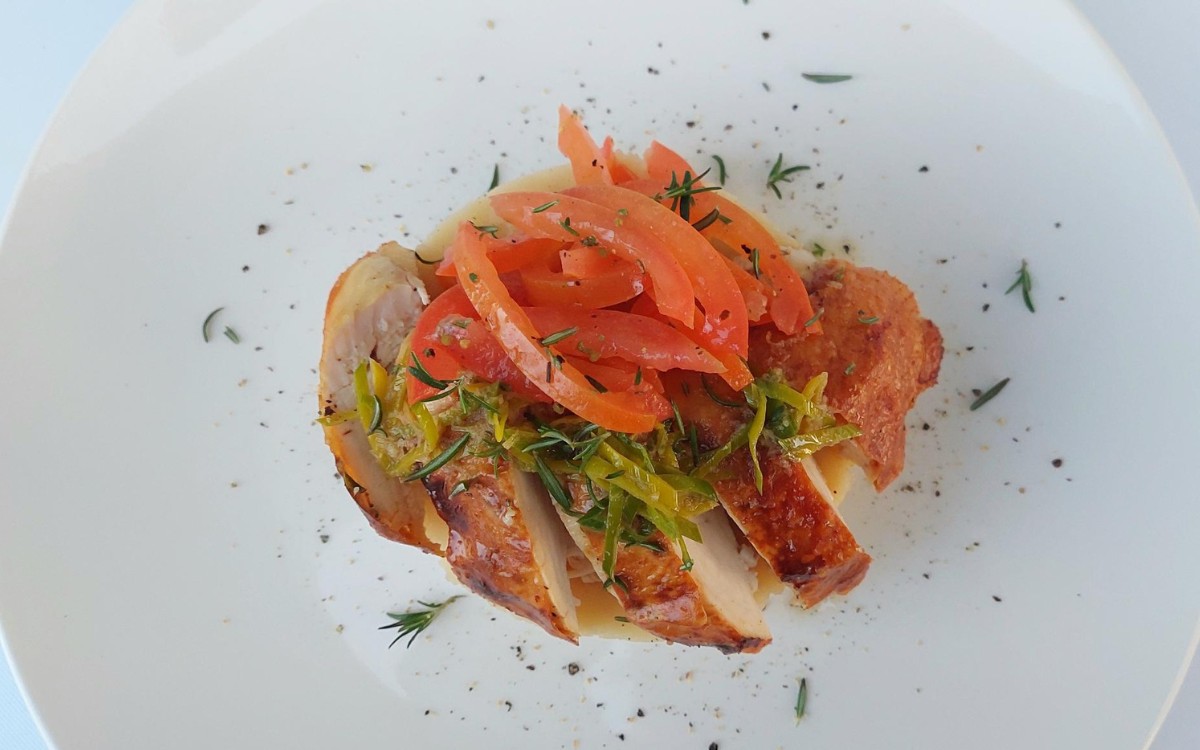
Drizzle With Intent
One of my favorite plating techniques is taking advantage of the beautiful trail left when sauces and vinaigrettes are artfully drizzled onto the plate. I get creative with smears, straight lines, dots, and other patterns to adorn proteins or seasonal vegetables. Drizzling brings elegance through both taste and presentation.
Garnish With A Purpose
No plated dish is complete without a perfect garnish. Sprigs of fresh herbs, edible flowers, chopped nuts, and microgreens. These are my go-to garnishes to provide the final touch. I carefully select and position garnishes to complement other components. This is like a frame that completes a painting. This thoughtful detail finishes the food presentation.
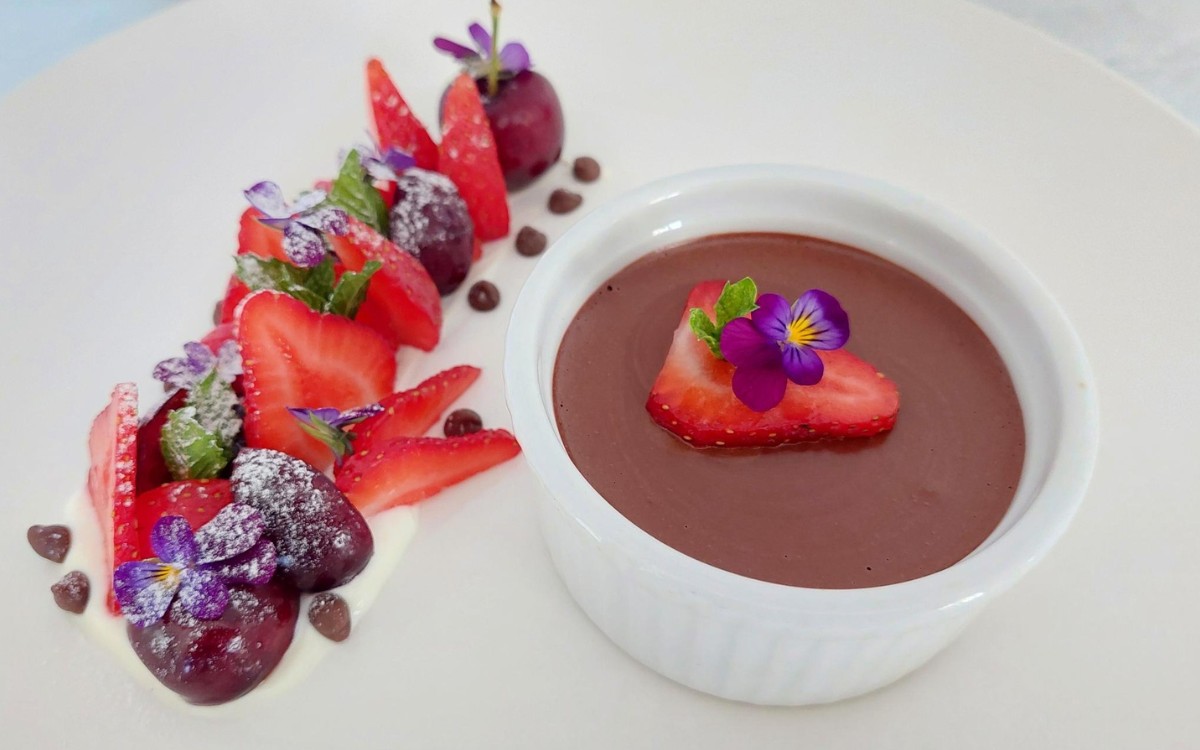
Use Plating To Tell A Story
In my view, the best plating tells a thoughtful story. The ingredients, flavors, and preparation involved in crafting the meal are conveyed through a harmonious arrangement. Seasonality and passion come across in the details. This storytelling instills pride and attention to detail in my cooking.
Experiment With Plate Styles
An often overlooked plating tip is choosing plates, boards, and surfaces that complement the food. Patterns on plates can frame simply presented dishes. Wooden boards offer rustic charm while sleek slate can modernize a presentation. I get creative with my “canvas” to enhance the overall dining experience.
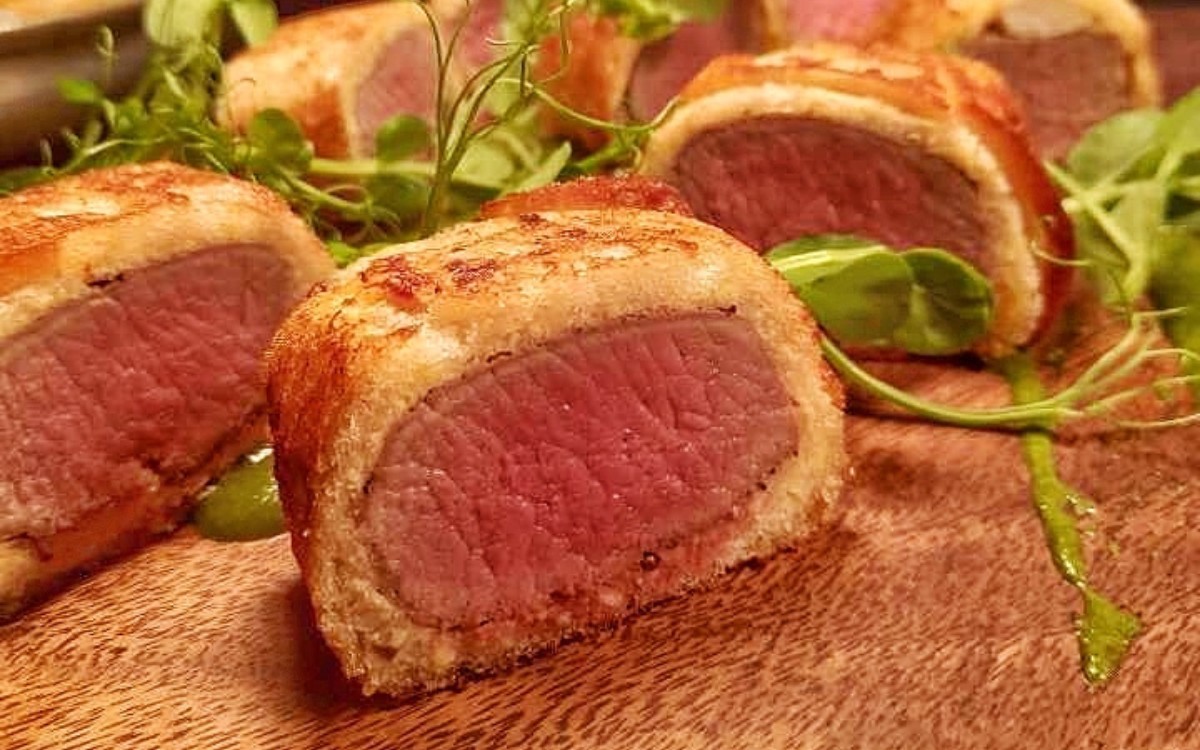
Develop Your Own Style
Just like with cooking techniques, plating has recognizable styles. Find what you love by looking at inspirational photos and experimenting. Over time, my personal plating preferences emerged into my signature style. Then I refined and perfected it. Maybe you prefer minimalist plates or architectural presentations. Your unique style is part of the art.
Practice Plating At Home
Even during home-cooked family meals, I practice plating in ways that feel fun and creative. The more you deliberately compose dishes with care, the more second nature beautiful presentation becomes. Use low-stakes at-home meals to hone your skills.
Invest In Quality Tools
Having quality tools at your fingertips facilitates plating success. I recommend investing in small spoons, tweezers, squeeze bottles, a melon baller, and other specialty items. The right kitchen tools allow you to intricately stack, drizzle, and embellish with ease. They’re essential for every aspiring platter.
Helpful Resources
Chef’s non-negotiables that separate the amateurs from the pros.
- A Beginner’s Guide To Kitchen Slang Culinary Lingo All Aspiring Chefs And Cooks Should Know
- A Day In The Life Of A Chef Knives Fire And Passion
- Sourcing Seasonal Ingredients To Inspire Your Home Cooking
What Are Some Basic Plating Tips For Beginners To Improve Presentation?
Some basic plating tips are to start with evenly portioning ingredients. Use odd numbers for garnish. Use height to add dimension, and incorporate contrasting colors and textures. Leave negative space around components, and pay attention to the plate style. Even simple improvements can make a difference.

What Are Common Plating Mistakes To Avoid?
Here are some of the common plating mistakes to avoid. Crowding the plate, not leaving negative space. Lack of color contrast, sloppy or uneven drizzles. Overcomplicating the presentation, and poor proportions that don’t highlight the star ingredient.
A common mistake I see when cooks are plating food is the lack of height. They place everything on the plate which makes the dish look one-dimensional and boring. Another common mistake I see is minimal to no garnishes.
How Do I Come Up With Unique Plating Ideas?
Ways of coming up with unique plating ideas are drawing inspiration from nature, artwork, and other chef’s plating ideas. Also, telling a story about the dish’s flavor profiles can guide the presentation.
Final Thoughts
Perfectly executed taste with artful presentation creates a sensational dining experience. Mastering plating techniques demonstrates a passion for food and visual aesthetics that diners notice and appreciate.
I encourage all cooks and chefs to view every plate as a new opportunity to create food into an artistic showpiece. With practice, you can learn to plate dishes as skillfully as you craft the flavors. Turn every meal into a visually stunning culinary delight for patrons.
Skillful food presentation makes for an exciting dining experience. It touches all your senses and demonstrates the care and creativity the chef has put into the food. Food presentation it’s easier than you think.
You May Also Like This

Embrace Eco-Friendly Cooking Your Path To Sustainable Deliciousness
- August 23, 2023
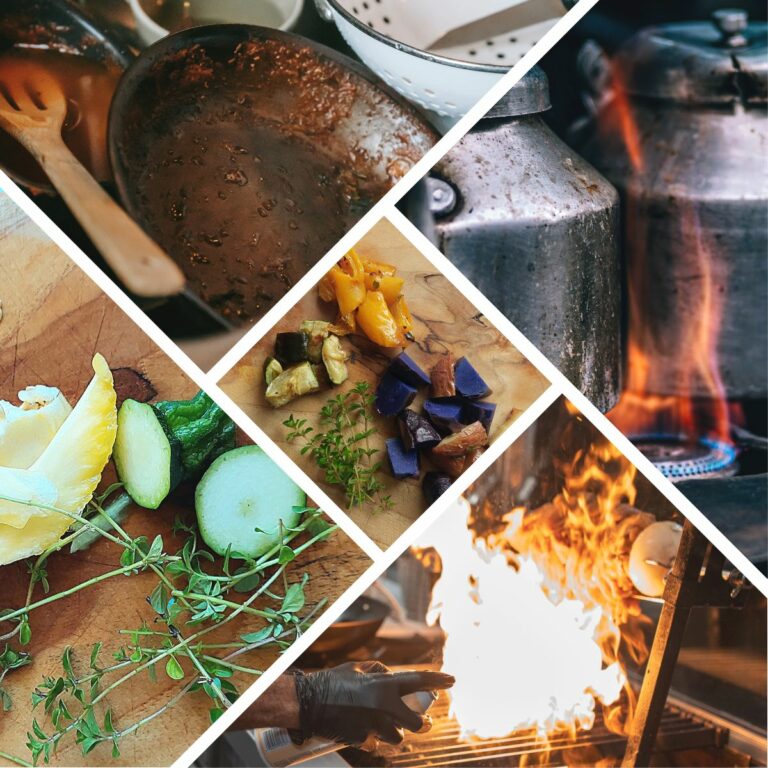
Coming Back From Culinary Failure: A Painful Lesson And Fantastic Teacher
- February 13, 2024
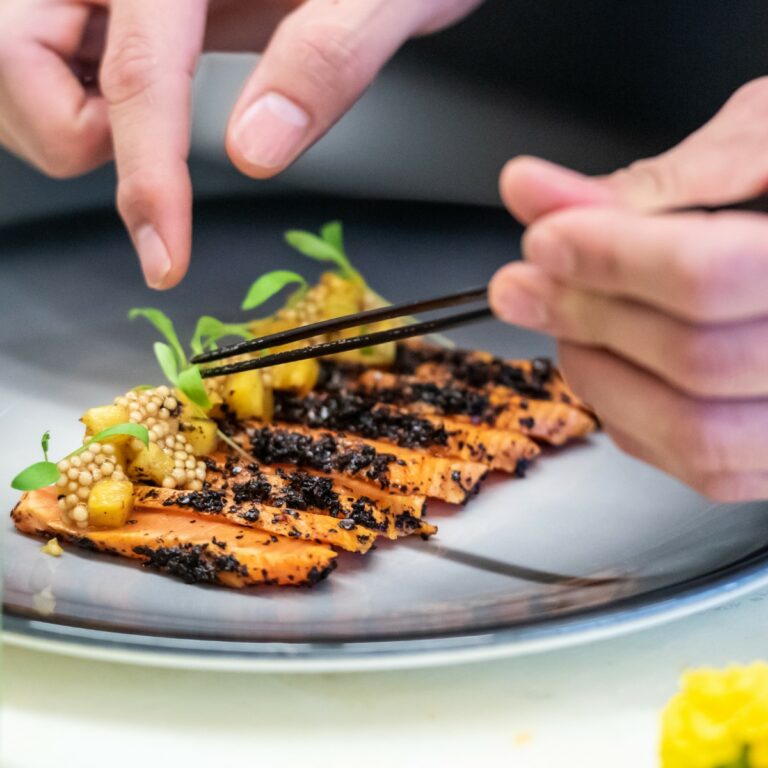
- January 28, 2024

Culinary Confidence Boost With These 12 Simple Recipes For Beginners
- January 31, 2024
Kindly note that orders placed on Wednesdays after 6PM (EST) will be shipped the following week (some exceptions may apply for local deliveries in the NYC area).

Item added to your cart
The art of food presentation: tips and techniques.
The art of food presentation goes way beyond garnishing. It's a visual way to introduce the meal's culinary story and give the diners a glimpse of the flavor that awaits them. If you've ever heard the phrase “one eats with his eyes first”, in the culinary world, this statement is unequivocally true. If there's one thing hospitality experts agree on, it's that food presentation is crucial to the entire dining experience.

The aesthetic arrangement of food on the plate is a chef's silent message to the diners, inviting them to savor not just the taste but the culinary journey. If you're finding food presentation difficult, you'll want to read this article to the end, as we will unearth everything you'll need to know to make your food presentation a masterpiece.
Importance of visual appeal in food preparation
Having known that we first eat with our eyes before our mouth, it's a no-brainer why visual appeal is as crucial as the food itself. Here are some reasons why it matters:
Influence diners' perception and acceptance of food
The visual presentation of the food is the first thing guests will notice. A well-presented dish often entices eaters and leaves a memorable first impression. Research has shown that plating food in an aesthetic manner makes diners see the food as more sophisticated and, consequently, are ready to pay more.

Enhanced Appetite
Colors, shapes, and food arrangements can add energy and trigger hunger. Bright colors like red, yellow, and green revive appetite and present food as natural. Also, complementary colors add a visual appeal to the food. When these colors are blended properly, it raises diners' anticipation of the food, and they are ready to eat more. The color of your plateware also highly affects the overall presentation which we will address in this article.
Reflects Quality
The dish's visual appeal speaks volumes about the food preparation, and the level of care to execute the dish. Also the environment where the guest is, the cleanliness of the linens, glassware or silverware, are elements that will tell a lot about the hygiene of the food and venue. Even if it's a high-end restaurant and food is presented in a shabby manner, or the venue is not well looked after, then diners will go with the notion that the dish was prepared in an unsafe environment using low-quality ingredients and that the standards of the venue are low.
Marketing and Social Shares
We are in an age where a simple post on the internet can go viral and gather over a million views in a few hours. Suppose visitors love their food presentation and dining experience. In that case, they are most likely to take pictures of the food or environment to post on their social media handles, which has a high possibility of attracting first-time visitors and repeat customers if the post goes viral. For the hospitality industry, this is earned marketing and low-cost advertising spreading across the social media network.
Techniques to Enhance Food Presentation
Whether you're a professional chef or a home cook, your plating process can make a big difference in how it is received. Here are some top food plating techniques to enhance food presentation:
Landscape plating

Landscape gardeners inspire this style of plating. It comprises long and low placement of food across the plate. It also gives a natural and artistic look to dishes, enhancing the flavor and texture of the ingredients. This style can be used on any dish, both main dish, appetizers, and desserts . To get the best output, cut each item into bite sizes.
Classical plating
It is a traditional and symmetrical plating technique that allows diners to see the elements on the plate vividly. This method uses starch, vegetables, and the main for the food arrangement. You'll have to view your plate like a clock. Protein should be placed between 3 and 9 o'clock, carbohydrates/starch between 9 and 12, and vegetables should be placed between 12 and 3.
Free form plating

The free-form plating allows for a more relaxed and asymmetrical food placement. Unlike the classic plating, where each element has a specific place, the free form allows for creativity. You can use cooking methods like smearing, scattering, or stacking to create a visually appealing dish.
Food on organic material techniques
This food presentation style uses natural materials like wood, stone, and slate as plating devices. It gives a rustic and natural feel to the dishes. You can use this technique for different occasions so long the plating and materials are safe, clean, and suitable for the food.
The bathing technique

The bathing technique presents the main dish in a pool of sauce or broth. This food plating style creates a more flavorful and eye-catching look for your dish and also the texture of the food. You can use the bathing technique for Tortellini with shellfish sauce or for a soup consommé, you can place your vegetables in the bowl and pour the soup broth at the table for a wow effect!
Creative Plating Ideas to Impress Your Guests

Whether you're serving up modest fare or fine cuisine, there's no one way to plate food. However, some important factors must be considered when presenting your food. But the rule of thumb is that the food's taste should match its looks. Here are the top food plating ideas that will help you plate food like a chef.
Tailor plating style to your evening’s concept.
You must give diners a more cohesive experience. Ensure your plating style matches your theme. If you have ethnic and casual dining, a hearty presentation using traditional dishware will be most suitable. For a fine-dining feel, using wares that exude luxury and affluence will be perfect, while for a family-style service, you can aim for colorful large plating. To get the most suitable plating for your party, you'll have to study your theme and guests to know what best fits.
Simplicity is key
One way to ensure simplicity is to pick one ingredient to be the spotlight on the plate. Clutters cause distractions, and most times, diners get confused about where to begin. To get this right, you should incorporate negative space. It will help draw diners' attention to the main element of the dish. Also, ensure that the plate complements the dish. Don't be under pressure to fill up the plate. You'll have to get different plates and proportions for different dishes.
Height and layers
Think of this like a landscape; placing elements at different heights adds depth to grab attention. For example, you can place mashed potatoes as your base and layer a piece of grilled chicken on top, then garnish it with steamed asparagus while standing upright. With this, you'll have starch at the bottom, protein in the middle, and vegetables upwards.

In French cuisine, the selection of tableware is vital to the overall presentation of the dish. Carefully choose plates, bowls, and platters that not only match but elevate the aesthetic qualities of the food. The design of the tableware is often minimalistic, directing attention squarely on the culinary creation itself. For your tablewares you can use white or light shades; they'll blend well with garnishes and sauces.
Use suitable tools
Using the right tools is crucial when plating food. It helps elevate the presentation of your dish to match the effort you've put into the meal preparation. Some of the common tools you'll need include a precision spoon, sauce squeeze bottle, tweezer, brush, round cutters, and spatula. These tools allow for greater control and finesse.
Utilizing Colors and Textures in Food Presentation
Colors and textures elevate the dining experience. When applying to food placement, you must ensure that there's a balance. Aside from this, it would be best if you considered contrast. When contrasting colors are used, the presentation stands out—for example, using a bright red color on a bed of green lettuce. There are no rules. You're free to use any style, seasonal colors, or color wheels, but you must ensure that the colors are harmonious, i.e., they blend perfectly. Garnishes add texture, and cooking techniques like grilling or broiling can add texture to your dish.
The Role of Garnishes and Edible Decorations
Add textural contrast and flavors: Some garnishes, such as crouton on soup or fried onions and shallots, toasted nuts on salad, add textural contrast that makes food taste better. Also, garnishes like fresh herbs or citrus zest add a complementary taste to the dishes.
Signals ingredients and culinary creativity: Garnishes give visual clues about the ingredients used to prepare the dish . For example, if a diner picks up the menu and sees Rosemary on a lamb dish or a mint leaf on a dessert, they know what flavors to expect. Garnishes let chefs show off their creative and artistic skills when presenting food.
Edibility: Unlike inedible decorations like toothpicks and ornamental skewers, garnishes could be eaten along with the dish. This offers an exquisite dining experience where every element on the plate contributes to both the flavor and presentation.
Final thought
Mastering the art of food presentation is akin to narrating a story that engages the guests’ senses even before the first bite. It's about harmonizing the aesthetics with the flavors, creating not just a meal but an immersive dining experience that will be complete by considering elements such as linen, tableware, "art de la table," flowers, music, and lights.
Also, incorporating BBQ grill ideas and popular French gourmet items can introduce a unique and savory element to your presentation. French cuisine is celebrated not only for its exquisite flavors but also for its artistic presentation, providing valuable insights into elevating your plating style.
Recent Food Blog

Best French Food Christmas Gifts to Delight Your Loved Ones
Discover an exquisite selection of outstanding French Christmas gifts from Dufour Gourmet. Whatev...

A Guide to Traditional French Christmas Food
Experience the magic of a French Christmas meal—an amalgamation of tr...

How to Prepare a Toulouse Sausage French Cassoulet
Bring the taste of southwestern France to your ki...
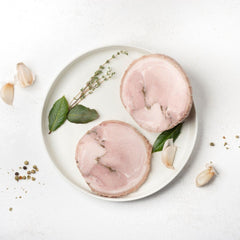
Porquette - Porchetta
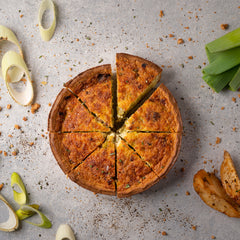
Bacon & Leek Quiche
- Choosing a selection results in a full page refresh.
- Opens in a new window.

Food Presentation 101: The Art of Plating and Garnishing by a Personal Chef
- October 20, 2023
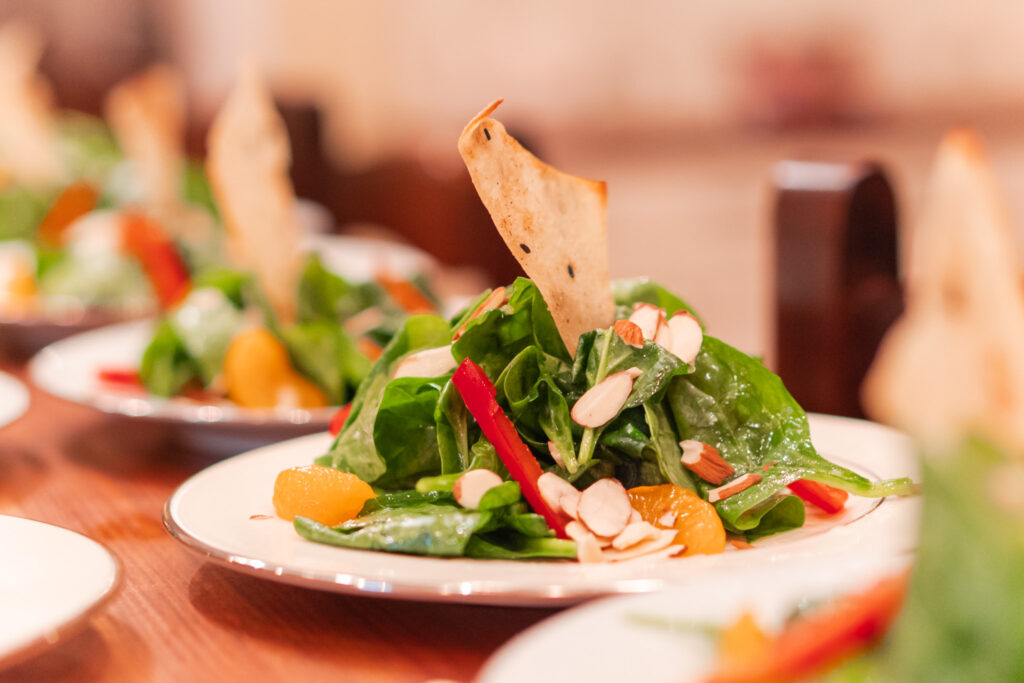
The visual appeal of a dish is just as important as its taste. Presentation plays a significant role in how we perceive and enjoy food. Personal chefs are masters in the art of plating and garnishing, using creative techniques to transform a meal into a visually stunning masterpiece. In this blog post, we’ll dive into the fundamentals of food presentation and explore how a personal chef’s expertise can elevate your dining experience.
1. The Importance of Food Presentation
Food presentation is the first impression your meal makes on the senses. A beautifully plated dish entices the eyes, creating anticipation and setting the stage for an exceptional dining experience. The way a dish is presented can enhance flavors, highlight key ingredients, and elevate the overall enjoyment of the meal.
2. Balance and Composition
Personal chefs understand the importance of balance and composition when it comes to food presentation. They consider elements such as color, texture, shape, and height to create visually appealing plates. By artfully arranging components, they strike a harmonious balance that not only pleases the eye but also enhances the dining experience.
3. Artistic Plating Techniques
Personal chefs are skilled in a variety of artistic plating techniques that add flair and creativity to their presentations. From delicate drizzles and intricate sauces to geometric arrangements and layered compositions, they use these techniques to transform a simple dish into a work of art. These techniques showcase their attention to detail and their ability to transform ordinary ingredients into extraordinary presentations.
4. Garnishing with Flair
Garnishes are the finishing touches that complete a plate. Personal chefs use garnishes to add pops of color, texture, and flavor to their creations. From vibrant herb sprigs and edible flowers to crispy toppings and intricate vegetable carvings, garnishes provide a visual and gustatory delight that elevates the overall presentation.
5. Presentation for Special Occasions
Personal chefs excel in creating visually stunning presentations for special occasions and celebratory events. They can design elaborate displays, incorporate decorative elements, and use thematic plating techniques to evoke the desired mood and ambiance. Whether it’s a romantic dinner for two or a grand feast for a milestone celebration, a personal chef’s expertise in food presentation ensures that the dining experience is as memorable as the occasion itself.
Food presentation is an art form, and personal chefs are the artists who bring dishes to life on the plate. Through their mastery of balance, composition, artistic plating techniques, and garnishing with flair, they elevate the visual appeal of meals and create memorable dining experiences. So, indulge your senses, appreciate the artistry, and let a personal chef transform your meals into visual masterpieces that are as delightful to look at as they are to savor.

Tavernay Parkway Charlotte, NC 28262
Office: (980) 216-CHEF
Serving the Charlotte and Triangle areas Raleigh, Durham, and Chapel Hill
COPYRIGHT © 2020 HEART AND SOUL PERSONAL CHEF- ALL RIGHTS RESERVED.


- Add Listing
The Art of Food Presentation: From Plate to Palate
- January 31, 2024
In the culinary world, food presentation is an art form that plays a crucial role in the dining experience. It’s not just about the flavors and textures of the dish but also about how it’s visually presented. This artistry is especially significant in high-end dining establishments, where every detail counts in creating a memorable meal.
The Evolution of Food Plating:
The history of food presentation is deeply intertwined with the evolution of culinary arts. In the past, the emphasis was primarily on the abundance and variety of food on the plate. However, with modern culinary techniques and the influence of different cultures, the focus shifted toward plating aesthetics. Today, chefs regard the plate as a canvas, where each dish element is thoughtfully placed to create a visually stimulating experience.
The Psychology Behind Food Presentation
It’s well-documented that the visual presentation of food can impact a diner’s perception and enjoyment. A beautifully plated dish can enhance the perceived taste andvalue, making the dining experience more enjoyable. This psychological aspect is why chefs invest time and creativity in appealingly presenting their dishes.
In top-tier restaurants, such as those found in Corona del Mar, the art of food presentation is taken to another level. Chefs in these establishments understand that the first impression of a dish can profoundly influence the diner’s overall experience. For instance, at a restaurant in corona del Mar , the presentation of a dish is carefully designed to tell a story, reflect the chef’s culinary philosophy, and showcase the quality of the ingredients.
Techniques and Trends in Plating
Chefs employ various techniques in food presentation, such as acts, texture variations, and strategic placement of ingredients. The goal is to create a dish that is as pleasing to the eye as it is to the palate. Contemporary trends in plating include minimalism, which focuses on simplicity and highlighting the quality of the ingredients, and maximalism, which involves more elaborate and decorative presentations.
The Role of presentation in dining experiences
The way a dish is plated and presented significantly contributes to the ambiance and theme of a restaurant. It reflects the chef’s attention to detail and commitment to providing an exceptional dining experience. In high-end restaurants, presentation is part of the narrative of the meal, contributing to the storytelling aspect of the culinary experience.
Chef Insights on the Importance of Presentation
Many chefs believe that the presentation of food is as essential as its taste. A well-presented dish not only appeals to the senses but also demonstrates the chef’s respect for the ingredients and their craft. The presentation is a form of expression, allowing chefs to convey their creativity and passion for food.
The Future of Food Presentation
As culinary trends continue to evolve, so will the techniques and styles of food presentation. With the growing influence of social media and food photography, the visual appeal of dishes is more important than ever. Chefs are constantly challenged to innovate and create visually captivating dishes that stand out and capture the diner’s imagination.
The art of food presentation is a fundamental aspect of the culinary experience, particularly in fine dining. It’s a testament to a chef’s skill, creativity, and attention to detail. A well-presented dish not only enhances the flavors but also enriches the overall dining experience, making it more is memorable and satisfying. The visual aspect of dining, as showcased in top-tier restaurants like those in Corona del Mar, plays a vital role in bridging the gap between the plate and the palate, turning a meal into an extraordinary experience.
- Previous Article
- Next Article
Related Blogs
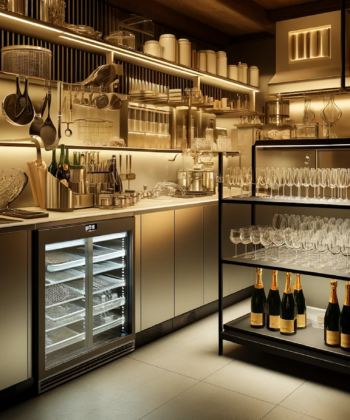
Champagne Service Simplified: Must-Have Equipment for Small-Space Restaurants
- December 18, 2024
Why Restaurants Should Adopt Omnichannel Communications
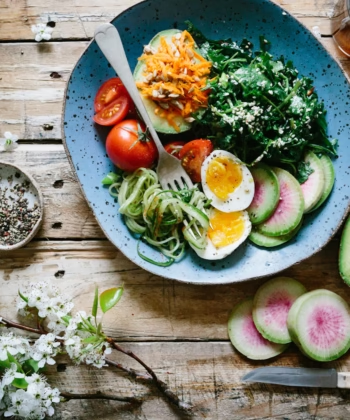
Let’s Learn About Nutrition: Everything a Busy Student Should Know
- December 16, 2024
The Art and Science of Food Presentation: Elevating the Dining Experience
Discover the fusion of art and science in modern food presentation. Explore sensory experiences, molecular gastronomy, edible flowers, and color theory in this guide for restaurant owners.

Nils Bjørnsen
Introduction.
In the realm of culinary arts, food presentation has evolved into a sophisticated blend of creativity and precision. The interaction between visual aesthetics and gastronomic experiences sets the stage for a culinary journey unlike any other. As diners seek not only taste but also visual stimulation, the art of food presentation plays a pivotal role in elevating the overall dining experience. From intricate plating techniques to the use of unconventional garnishes, every element on the plate contributes to a multi-sensory adventure. This article explores the intricate dance between artistry and science in modern food presentation, delving deep into the nuances that captivate diners worldwide. Join us on a voyage into the world where culinary innovation meets artistic expression, where each dish tells a story and every bite is a brushstroke on the canvas of flavors.
The Art of Food Presentation
Food presentation is a crucial element that bridges the gap between culinary creativity and visual appeal. It is the art of transforming a dish into a masterpiece that entices not only the taste buds but also the eyes. The first impression of a dish is often formed based on its presentation, setting the stage for the entire dining experience. The art of food presentation goes beyond mere plating; it involves a careful consideration of balance, colors, textures, shapes, and overall aesthetics. Each element on the plate plays a significant role in creating a harmonious visual composition that complements the flavors and textures of the dish. Chefs leverage various techniques to elevate the presentation of their creations, from minimalist arrangements that focus on the essence of the ingredients to intricate designs that showcase culinary craftsmanship. The use of negative space, strategic positioning of components, and creative use of garnishes are all part of the artistry behind food presentation. Furthermore, cultural influences, historical references, and seasonal inspirations often serve as sources of creativity for chefs looking to excite and surprise their diners. In essence, the art of food presentation is a symphony of creativity, skill, and innovation that adds depth and dimension to the dining experience, transforming a simple meal into a memorable culinary journey.
Sensory Experience in Dining
In the realm of dining experiences, the sensory aspects play a crucial role in shaping a guest's perception and enjoyment of a meal. Beyond taste alone, the amalgamation of sight, smell, touch, and even sound can elevate a dish from mere sustenance to a multisensory journey.
Visual presentation is often the first sensory encounter a diner has with a dish. The arrangement of components on a plate, the use of colors and shapes, and the overall aesthetic appeal can spark anticipation and set the tone for the culinary experience to come. A visually striking dish can evoke emotions and build excitement before the first bite.
Moving beyond sight, the olfactory sense is a powerful tool in evoking memories and enhancing flavor perception. Aroma can enhance the dining experience by preparing the palate for the flavors that follow. Chefs strategically use fragrant elements like herbs, spices, and infusions to captivate diners from the moment a dish is presented.
When it comes to touch, the texture of food plays a significant role in creating a satisfying sensory experience. The contrast between crunchy and creamy, tender and firm, adds dimension to each bite, engaging not only the taste buds but also the tactile senses. Texture can surprise and delight, adding complexity to the overall enjoyment of a dish.
Sound, although often overlooked, can also contribute to the sensory symphony of dining. The crisp crackle of a perfectly seared steak, the gentle pop of caviar, or the sizzle of a dish being flambeed can enhance the dining experience by providing auditory cues that complement the flavors and textures on the plate.
By crafting dishes that engage multiple senses, chefs have the opportunity to create immersive dining experiences that leave a lasting impact on guests. The interplay of sight, smell, touch, and sound harmonize to elevate a meal into a sensorial masterpiece, where every element adds to the symphony of flavors and sensations.
Molecular Gastronomy Techniques
Molecular gastronomy has revolutionized the culinary world, incorporating scientific principles and innovative techniques to transform traditional dishes into captivating works of art. This avant-garde approach focuses on the chemical and physical transformations that occur during cooking, resulting in visually stunning and flavorful creations.
One prominent technique in molecular gastronomy is spherification, which involves the transformation of liquids into spheres using calcium chloride and sodium alginate. These caviar-like spheres burst with flavor upon consumption, adding a delightful textural contrast to dishes.
Another fascinating method is foams, where ingredients are aerated to create light, airy textures. Foams can range from savory to sweet, adding a whimsical touch to plates and enhancing the overall dining experience.
The use of liquid nitrogen is a hallmark of molecular gastronomy, instantly freezing ingredients to create unique textures and presentations. Flash freezing with liquid nitrogen allows chefs to experiment with textures like never before, resulting in visually striking dishes that defy traditional culinary expectations.
Furthermore, emulsifications play a crucial role in molecular gastronomy, as chefs blend ingredients that wouldn't naturally combine to create stable and visually appealing sauces and dressings. This technique opens up a world of possibilities for creating innovative flavor pairings and artistic presentations.
Overall, molecular gastronomy techniques provide chefs with a blank canvas to unleash their creativity and reinvent traditional dishes, elevating the dining experience to a multisensory journey that surprises and delights guests.
Edible Flowers as Garnishes
In the world of culinary arts, using edible flowers as garnishes is a trend that adds not only visual appeal but also a unique flavor profile to dishes. These delicate blooms are becoming increasingly popular in food presentation for their ability to elevate a dish from simple to spectacular. Edible flowers can range from subtle to vibrant in color, providing chefs with a natural palette to enhance their creations. Roses, lavender, violets, and marigolds are just a few examples of flowers that are safe for consumption and can be creatively used in garnishing. When incorporating edible flowers, it is crucial to ensure they are organic and free from pesticides. These blooms can be added to salads, desserts, cocktails, and even main dishes, offering a touch of elegance and sophistication. Not only do they contribute to the aesthetics of a dish, but they also infuse a hint of floral aroma and flavor, engaging multiple senses during the dining experience. Chefs play with textures, shapes, and colors when using edible flowers, turning each plate into a work of art. The use of edible flowers as garnishes exemplifies the harmony between nature's beauty and the culinary craftsmanship, making every meal a visual feast for patrons.
Impact of Color Theory on Perception
Color plays a crucial role in food presentation, influencing not only the visual appeal but also the perceived taste and overall dining experience. Understanding the impact of color theory on perception can help restaurants create visually stunning dishes that captivate diners.
Color Psychology : Different colors evoke specific emotions and associations. For example, red is often associated with energy and passion, while blue conveys calmness and serenity. By strategically using colors in food presentation, restaurants can evoke desired feelings in their guests.
Appetite Stimulation : Certain colors, such as red, orange, and yellow, are known to stimulate appetite. These warm colors can make dishes appear more appealing and appetizing. In contrast, cool colors like blue and green are often used to create a sense of freshness and healthfulness in food.
Plate and Background Selection : The choice of plate color and background can significantly impact how the food is perceived. Plates that contrast with food colors can make dishes stand out, while complementary colors can create a harmonious presentation. Dark plates often enhance vibrant food colors, providing a striking visual effect.
Color Combinations : Harmonizing colors on a plate is key to creating visually balanced and aesthetically pleasing presentations. Complementary colors, such as red and green or blue and orange, can create a visually striking contrast. Monochromatic schemes using varying shades of a single color can also create a sophisticated look.
Cultural Influences : Different cultures associate colors with varying meanings. It's essential for restaurants to consider cultural preferences and taboos when selecting colors for food presentation to ensure they resonate positively with diners.
In conclusion, mastering the art of color theory in food presentation is a powerful tool for restaurants to enhance the dining experience, evoke specific emotions, stimulate appetite, and create visually appealing dishes that leave a lasting impression on customers.
Case Studies of Innovative Food Presentations
In this section, we will delve into a selection of compelling case studies that showcase the ingenuity and creativity of modern food presentation techniques.
Virtual Reality Dining Experience: Imagine diners putting on VR headsets to immerse themselves in a digital world where their food is dynamically transformed into interactive art pieces that change with each course. This innovative approach stimulates not just taste but also sight and touch, creating a truly multisensory dining adventure.
Levitating Desserts: Some restaurants have taken dessert presentation to new heights by serving levitating sweet creations. Using magnetic levitation technology, desserts appear to float above the plate, mesmerizing diners and adding an element of whimsy to the dining experience.
Projection Mapping on Food: Projection mapping techniques are being used to project visually stunning animations onto dishes, turning them into moving canvases of art. From changing patterns to storytelling through visuals, this form of presentation adds an interactive and dynamic dimension to the dining table.
Interactive Plating Stations: Picture diners customizing their own plates at interactive plating stations equipped with edible paints, brushes, and garnishes. This hands-on approach empowers guests to become artists, encouraging creativity and personalization in their dining experience.
These case studies exhibit how innovative food presentations can elevate not only the visual appeal but also the overall dining experience, creating unforgettable moments that linger in the minds of guests far beyond the meal itself.
In conclusion, mastering the art and science of food presentation is a transformative journey that can elevate the overall dining experience. By intertwining creativity, precision, and an understanding of sensory perception, chefs and restaurant owners can captivate their customers in ways that go beyond taste alone. The fusion of artistic flair and gastronomic innovation not only delights the palate but also engages all the senses, creating a truly memorable meal. From molecular gastronomy techniques to the strategic use of color and the embellishment of edible flowers, every element plays a crucial role in shaping diners' perceptions. Through constant experimentation, attention to detail, and a commitment to pushing boundaries, restaurants can create visually stunning and emotionally resonant dishes that leave a lasting impact. Embracing innovation and exploring new horizons in food presentation paves the way for culinary excellence and ensures that every meal becomes a work of art in its own right.
Sign up for more like this.

IMAGES
COMMENTS
Food presentation is the art of modifying, processing, arranging, or decorating food to enhance its aesthetic appeal. The visual presentation of foods is often considered by chefs at many different stages of food preparation, from the manner of tying or sewing meats, to the type of cut used in chopping and slicing meats or vegetables, to the ...
Well-executed food presentation can create a sense of professionalism in the mind of eaters and offers an exciting element of a meal that many can't recreate with the same skill in their own cooking efforts. In the digital age, strong presentation can also make dishes more apt to be photographed and shared via social media.
Presentation is based solely on creativity, so while certain techniques and trends can be taught, original ideas need to come from the individual. Noifelt told us that food carving, in particular, is a balance between technical skill and creative thought. It takes talent and a lot of practice time in order to learn intricate food presentation ...
Try keeping all presentation of the food relevant and simple. A nice formal dish is great for a celebration, but even simple meals can be improved with the addition of some herbs. Thanks. Helpful 0 Not Helpful 0. Read current cooking books and magazines for ideas. Your local library is a wonderful resource and many culinary magazines are now ...
Skillful food presentation makes for an exciting dining experience. It touches all your senses and demonstrates the care and creativity the chef has put into the food. Food presentation it's easier than you think. Previous Post A Beginner's Guide To Kitchen Slang — Culinary Lingo All Aspiring Chefs And Cooks Should Know .
The visual presentation of the food is the first thing guests will notice. A well-presented dish often entices eaters and leaves a memorable first impression. Research has shown that plating food in an aesthetic manner makes diners see the food as more sophisticated and, ...
Food presentation is an art form, and personal chefs are the artists who bring dishes to life on the plate. Through their mastery of balance, composition, artistic plating techniques, and garnishing with flair, they elevate the visual appeal of meals and create memorable dining experiences. So, indulge your senses, appreciate the artistry, and ...
Conceptualize plating as an art form: you are the artist; the plate is your canvas, and the food is your medium. Master the following plating techniques to perfect your craft. 1. Plate Presentation Techniques. Selecting the right plate for your meal is the first step in the food presentation process. Consider the following to choose the ideal ...
The art of food presentation is a fundamental aspect of the culinary experience, particularly in fine dining. It's a testament to a chef's skill, creativity, and attention to detail. A well-presented dish not only enhances the flavors but also enriches the overall dining experience, making it more is memorable and satisfying.
Food presentation is a crucial element that bridges the gap between culinary creativity and visual appeal. It is the art of transforming a dish into a masterpiece that entices not only the taste buds but also the eyes. The first impression of a dish is often formed based on its presentation, setting the stage for the entire dining experience. ...